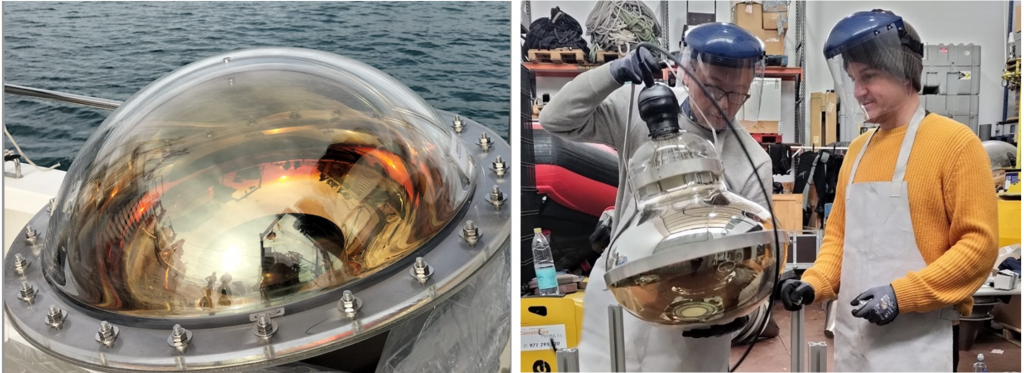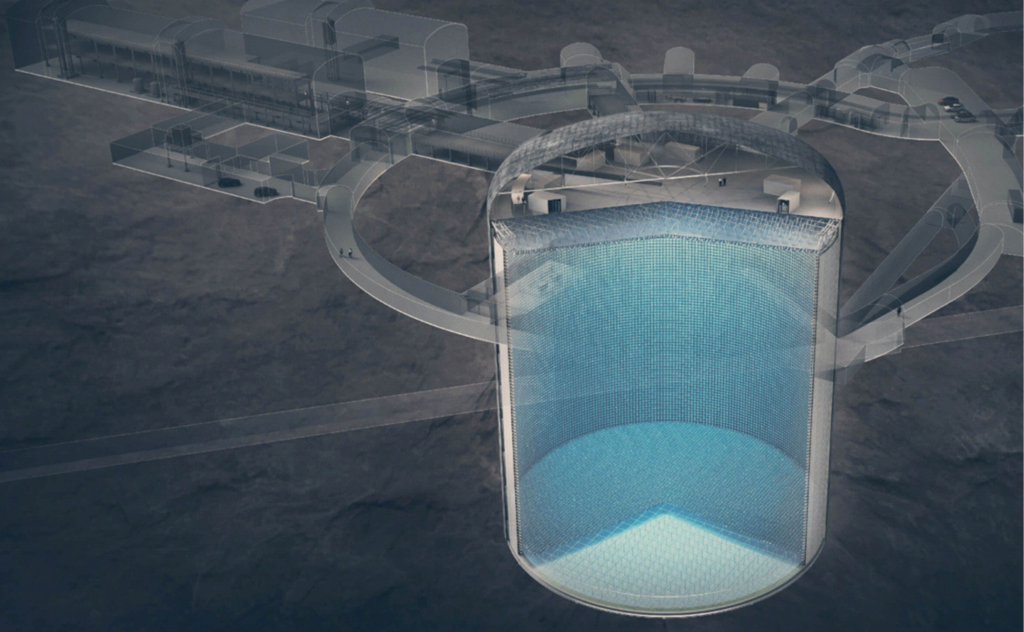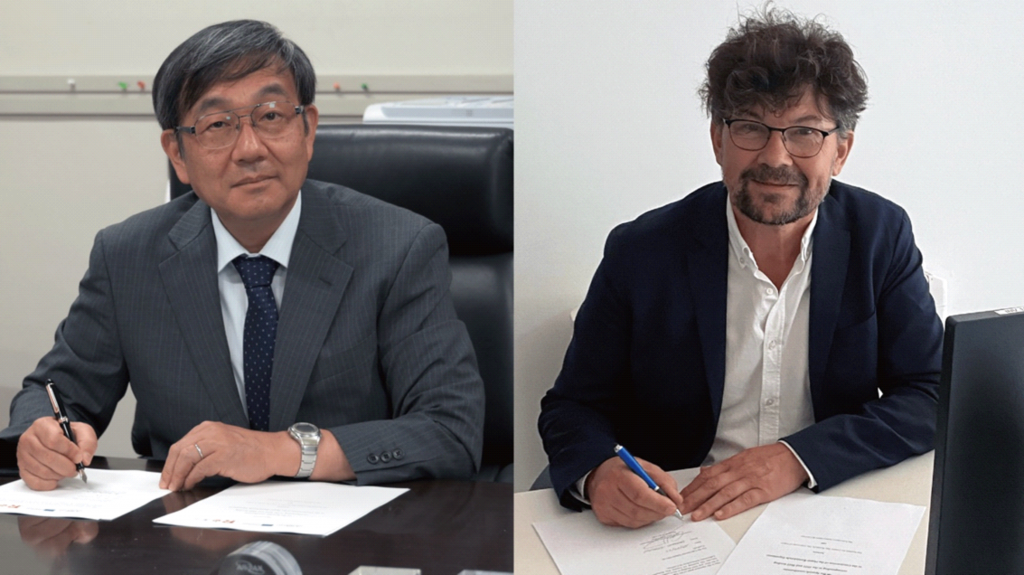
15 Feb AMADE participates in an underwater experiment to help discover the secrets of the Universe
- The Canfranc Underground Laboratory (LSC) is coordinating an experiment to test the safety of the technologies of the future international Hyper-Kamiokande (HK) telescope, which will be the largest neutrino detector in the world.
- The experiment is part of the Spanish participation in the design, construction and start-up of HK, based in Japan, of which our country is the full owner.
- Spanish researchers and engineers will work with the data obtained from the experiments and will be part of the discoveries made in this underground telescope.

Neutrinos are a key piece to know how the Universe originated and to have information about some astrophysical phenomena such as the formation of a supernova. Despite being the second most abundant particle in nature, it is extremely difficult to detect. Neutrinos lack electrical charge, have almost zero mass, and cannot be seen directly; That is why they are known as the “ghost particle”. Usually, they pass through matter without leaving a trace, but sometimes neutrinos collide with matter and a burst of blue light is produced, called “Cherenkov light,” which ultrasensitive photosensors (a kind of giant light bulb, half a meter in diameter), are able to observe.
Led by the LSC, as coordinator of the Spanish participation in HK, a Spanish-Japanese team is currently carrying out a three-week campaign to test the viability of two types of protective covers for the photosensors, manufactured in Spain, to improve detection. safe from neutrinos.
The team working on this campaign is made up of 12 scientists and technicians from the Donostia International Physics Center (DIPC), of the University of Girona; and the Cosmic Ray Research Institute of the University of Tokyo, a partner leading the project in Japan; in addition to members of the LSC.

During these experiments, aboard the oceanographic vessel B/O SOCIB, the team aims to replicate in the Bay of Palma the conditions that the photosensors will have in Hyper-Kamiokande, currently under construction. This Japanese facility, 600 meters deep in the Kamioka mine, will have a drum-shaped tank 71 meters high and 68 meters wide, a capacity for 260,000 tons of ultra-pure water, and will be lined with 20,000 photo sensors. highly sensitive to detect neutrinos from any part of our galaxy, including those generated at the J-PARC accelerator, located about 300 km away.
Image of the structure with the giant light bulbs prepared for the experiment. /LSC.
The director of the Canfranc Underground Laboratory, Carlos Peña, details the experiment: “From the ship, we submerge a metal structure, with one or more light bulbs, up to 80 meters deep, which subjects them to nine bars of pressure, above of what will happen at the Japanese facility. Next, we press a light bulb in a controlled way to study the implications when it explodes. What we are looking for is that, when the light bulb implodes due to pressure, the pressure wave generated does not produce a chain reaction that destroys the rest.”

Such a problem would be a disaster, as already happened in Super- Kamiokande, eight times smaller than HK. In 2001, one of the photo sensors imploded, causing the destruction of 7,000 of its 11,000 light bulbs. Due to the gigantic dimensions of the HK, which will initially house 20,000 photosensors, these requirements must be higher than the previous ones, and the technology is planned to the millimeter. For this reason, the contribution of the Spanish team in the design, manufacturing and execution of the experiments that are currently being carried out is essential.

Materials manufactured in Spain
The bulbs that will cover the HK are protected with a steel casing and a particularly resistant and transparent methacrylate dome, which will protect the rest of the detector in the event of one of the bulbs breaking. Researchers are now focusing on selecting the best prototype for this.
During the experiment, the viability of two different protections is being tested. One designed by the Japanese team, which has been used until now in Super- Kamiokande, an improved version of the one used until now in Super- Kamiokande, and another design entirely by the Spanish team.
“The manufacturing of both prototypes is being coordinated with Spanish companies, which represents an important boost for the country’s industry,” details the director of the LSC. Several Spanish steel and acrylic companies such as Acerinox, Lasa, Matriçats and Emacryl participate in the manufacture of different components.
Spanish teams in the largest neutrino telescope in the world
In addition to the study, design and construction of the photodetector protection capsules, the Spanish team participates in Hyper-Kamiokande by providing the design and construction of the geomagnetic compensation system and the main installation of the radon-free air provision system throughout The underground infrastructure will also provide the design and electronic components, and the storage systems for the use of artificial intelligence in the reconstruction and analysis of facility data.
This contribution, within the strategic plan for international collaboration in science of the Ministry of Science, Innovation and Universities, places Spain as one of the full owners of the largest neutrino telescope in the world, which will be launched in 2027. Therefore, the Spanish teams will participate in the experiments, share data and contribute to future discoveries of this infrastructure, which is expected to be at full capacity for more than two decades.

The Spanish Hyper-Kamiokande consortium, coordinated by the Canfranc Underground Laboratory (LSC), is made up of nine institutions: the Center for Astroparticles and High Energy Physics (CAPA) of the University of Zaragoza, the International Physics Center of Donostia ( DIPC), the Institute of High Energy Physics (IFAE), the Autonomous University of Madrid (UAM), the University of Girona (UdG), the University of Oviedo (UO), the Polytechnic University of Valencia (UPV) and the University from Santiago de Compostela (USC). At the UdG level, AMADE is the research group involved in the project.
The participation of the oceanographic vessel B/O SOCIB in the experiments is carried out through a collaboration agreement with the Canfranc laboratory, through the national network of Unique Scientific and Technical Infrastructures (ICTS), of which both are part.
THE CANFRANC UNDERGROUND LABORATORY (LSC)

The LSC, excavated 800 meters deep under the Tobazo mountain in Canfranc, is the second largest deep-sea laboratory in Europe. In this center, a hub for researchers from around the world, cutting-edge research on astroparticle physics, geodynamics and biology is carried out.
The depth of the location in the Aragonese Pyrenees filters cosmic radiation. This “cosmic silence” is fundamental for research into the physics of neutrinos, dark matter and other unusual phenomena in nature, since they require very low environmental radioactivity to be observed.
The LSC, which belongs to the national network of Unique Scientific and Technical Infrastructures (ICTS), is a consortium created by the Ministry of Science, Innovation and Universities, the Government of Aragon and the University of Zaragoza.



